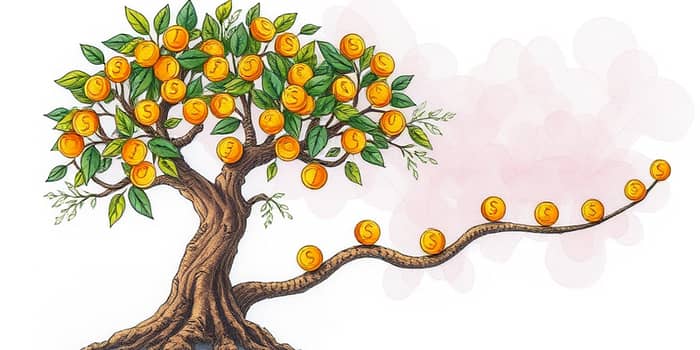Compound interest has long been recognized as the cornerstone of personal finance, offering powerful interest on interest effect that helps your savings grow faster than simple deposits alone. By understanding how this mechanism works, you can learn to let your money work tirelessly in the background, unlocking opportunities that many overlook.
Thousands of investors have built substantial nest eggs by committing small periodic savings. Understanding compounding transforms everyday decisions into strategic moves, empowering you to grow your wealth confidently.
Understanding Compound Interest
At its core, compound interest is the process of earning interest on both the original principal and on interest that was previously added. This creates a snowball effect where returns accelerate as time goes by. In contrast, simple interest only calculates returns on the initial amount, resulting in linear growth.
Embracing the principles of compounding means you can unlock exponential growth potential by consistently reinvesting your earnings. Whether you are saving for retirement, a home purchase, or emergency funds, compound interest can turn modest contributions into substantial balances.
Essential Formulas Explained
Essential compound interest formula: A = P (1 + r/n)^(n*t), where A is the ending balance, P is the principal amount, r is the annual interest rate (decimal), n is the number of compounding periods per year, and t is the total number of years. This formula captures the accelerated growth achieved through compounding.
Simple interest calculation formula: I = P × r × t, where I represents the interest earned over time. Because simple interest ignores previously earned returns, your balance increases at a constant rate, making it less advantageous for long-term saving.
Simple vs. Compound Interest
To illustrate the difference, consider this summary comparison:
Real-Life Examples
Imagine depositing $1,000 at a 5% annual rate, compounded once per year. After the first year, you earn $50, bringing your total to $1,050. In year two, you earn interest on $1,050, not just the original $1,000. This yields $52.50 in year two, and $55.13 in year three, reaching a balance of $1,157.63. By comparison, simple interest would only produce $1,150 after three years.
If you increase compounding frequency to monthly, your returns grow even faster. At the same rate, month-by-month computations deliver slightly higher balances each period. Small differences compound over years, demonstrating how compounding frequency becomes a strategic advantage for disciplined savers.
Consider higher rates: £1,000 at 10% annual compounding yields £1,100 after year one, £1,210 after year two, and £1,331 after year three. Over five years, this £1,000 grows to £1,610.51. If simple interest were used, the same scenario would only provide £1,500, demonstrating how higher rates magnify the compounding advantage.
The Miracle of Time
Often called the “eighth wonder of the world,” compound interest delivers its greatest rewards when given ample time. A $10,000 investment at 7% compounded annually can double in approximately 10.3 years, according to the Rule of 72 (72 ÷ interest rate). Over several decades, even modest rates translate into accelerating growth over time that can fund comfortable retirements and long-term goals.
Legend has it that Albert Einstein referred to compounding as the eighth wonder of the world, emphasizing its capacity to astonishing long-term wealth-building engine for those who harness it wisely.
Starting early is crucial. Investing consistently in your twenties, even in small amounts, can yield larger nest eggs than starting later with bigger monthly contributions. This principle underscores the importance of making compounding work in your favor from the outset.
Compounding Frequency and Effective Rates
The impact of compounding frequency can be profound. Common compounding intervals include:
- Annually
- Semi-annually
- Quarterly
- Monthly
- Daily
- Continuously
Financial institutions often advertise nominal rates, but the true return is reflected in the Effective Annual Rate (EAR) or Annual Percentage Yield (APY). When interest compounds more frequently, the EAR or APY exceeds the nominal rate, delivering higher yields for depositors.
Strategies to Harness Compound Interest
To maximize compounding benefits:
- start investing early to succeed by giving interest more time to accumulate.
- Prioritize accounts with small amounts yield big returns potential through higher compounding frequencies.
- Reinvest all earnings; avoid withdrawing interest directly.
- Make regular contributions, even when markets fluctuate.
Smart selection of accounts, such as retirement funds (401(k) or IRAs), high-yield savings, or reinvested dividends in brokerage accounts, can transform modest savings into substantial wealth over decades.
Reading charts, experimenting with spreadsheet software, or using online calculators can help you visualize compounding effects. By inputting different rates, timeframes, and deposit amounts, you gain personalized insight and motivation to stay on track.
Beware the Other Side of the Coin
Compound interest is a double-edged sword. When applied to debt, it can dramatically increase what you owe. Credit cards, payday loans, and certain high-interest mortgages compound daily, turning small balances into heavy burdens if left unpaid. Borrowers must understand compounding to avoid spiraling debts.
- Credit card balances often compound daily, leading to escalating charges.
- Payday loans can double or triple within a short period due to high rates.
- Certain adjustable mortgages may capitalize unpaid interest.
Conclusion
Compound interest remains one of the most potent tools in personal finance, enabling financial peace of mind when leveraged correctly. By appreciating the mechanics, formulas, and strategies detailed above, you can use time as your ally, growing small contributions into long-term security.
Remember, consistency and patience are key. Whether you are just beginning or refining your investment approach, embracing compound interest will bring your financial goals within reach.
References
- https://www.centralbank.net/learning-center/compound-interest-and-why-its-important/
- https://www.westernsouthern.com/investments/simple-interest-vs-compound-interest
- https://en.wikipedia.org/wiki/Compound_interest
- https://www.capitalone.com/learn-grow/money-management/simple-interest-vs-compound-interest/
- https://www.bankrate.com/banking/what-is-compound-interest/
- https://www.amerantbank.com/ofinterest/simple-interest-vs-compound-interest/
- https://www.equifax.co.uk/resources/loans-and-credit/explaining-compound-interest.html
- https://www.bankrate.com/investing/compound-interest-vs-simple-interest/
- https://www.td.com/ca/en/personal-banking/advice/growing-money/what-is-compound-interest-and-how-does-it-work
- https://www.thrivent.com/insights/investing/simple-vs-compound-interest-explained
- https://www.securian.com/insights-tools/articles/how-compound-interest-works.html
- https://smartasset.com/investing/difference-between-simple-and-compound-interest
- https://www.consumerfinance.gov/ask-cfpb/how-does-compound-interest-work-en-1683/
- https://banzai.org/wellness/resources/simple-vs-compound-interest-calculator
- https://www.youtube.com/watch?v=WgVPgNFgrAo
- https://www.lendingclub.com/resource-center/personal-loan/compound-interest-vs-simple-interest-whats-the-difference
- https://web.stevenson.edu/mbranson/m4tp/version1/payday-loans-interest.html










